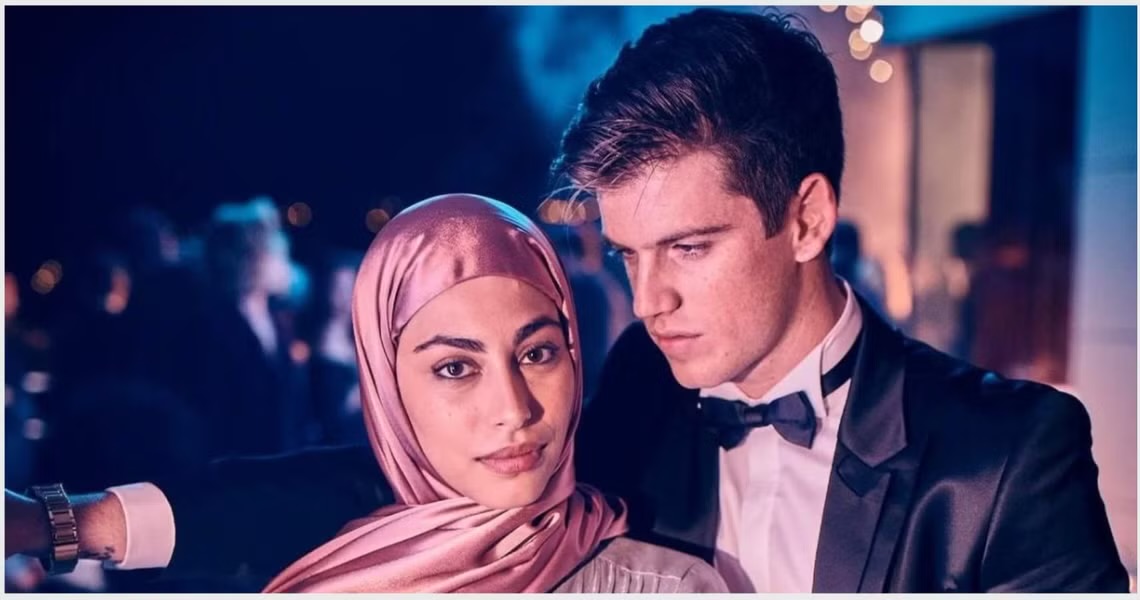Examining expected Muslim assimilation in Western society and unveiling Western hypocrisy and double standards
As Reflected in Elite (2018-)
A Dissertation
Submitted to the School of Humanities
University of Westminster
May 2024
TW: There are references to sexual acts within this essay due to the subject and nature of the analysis.
Introduction
Emphasised by Senanayake (2021, pg. 64), images exhibited on screen possess significant communicative efficacy, particularly within popular culture where cinematic portrayals serve as pivotal agents of discourse. This underscores the considerable influence exerted by Western cinema and visual entertainment in shaping perceptions of identity and perpetuating stereotypical depictions, notably those concerning minority and religious groups.
This phenomenon is particularly pronounced in the negative depiction of Muslims. As stated by Gentry (2018, pg. 2), “stereotypes and misrepresentations of Muslims are inextricably linked to the popular media,” with Hollywood being accountable for perpetuating problematic images of Muslims. Although there is a prevailing belief that Muslims have been vilified as a threat to national security due to the events of 9/11, such demonisation and marginalisation of Muslims predates this incident. As Senanayake (pg. 65) asserts, this stereotyping was initially shaped by the historical discourse of Western orientalism, characterising them through stereotypical representations since the inception of Hollywood.
The earliest depiction of Muslims in film was during the early twentieth century, in which the Islamic world was presented as enigmatic and exotic. These films featured veiled belly-dancing women, bearded sheikhs, and dark-skinned villains inhabiting desert landscapes dotted with palm trees and camels (Ramji, 2016, pg. 2). Examples of such depictions include films like The Unfaithful Odalisque (1900), The Arab (1915), and The Desert Song (1929). Despite appearing ostensibly better to the prevailing contemporary depiction of Muslims, such representations still failed to promote a positive image.
Senanayake (pg. 65) observes that this depiction of Muslims shifted due to occurring political dynamics. These dynamics included the establishment of Israel, the Iranian revolution, wars between the Arabs and Israelis, the oil crisis of 1973, and other significant events. Subsequently, by the 1970s, Muslims became synonymous with terrorism, and Islam was often perceived as a radical and belligerent faith engaged in conflict with the West. This perception led to the pervasive portrayal of an Islamic threat narrative in Western cinema (Ramji, pg. 3). As noted by Ramji (pg. 2), there has been a notable shift in cinematic representation: “The sheikh and lusty despot have slowly disappeared, leaving hijackers, kidnappers, and terrorists. Muslim women have disappeared behind the chador and burqa.”
Examples of this trend can be discerned in films such as Into the Night (1985) and Iron Eagle (1986), where Muslims were depicted as merciless terrorists posing a threat to the American way of life. Similarly, The Siege (1998) employs the term “terrorist” repeatedly to describe Muslims, reinforcing their portrayal as anonymous militant adversaries (Ramji, 2004, pg. 4).
The gradual emergence of Muslims being associated with terrorism received impetus post-9/11. Subsequently, debates in media and politics regarding topics concerning Muslims and Islam have become increasingly narrowed to an Orientalist discourse. Concurrently, the relationship between Western nations and Muslims has been reconceptualised as a division between the Western world and the world of traditional Islam (Ahmed and Mattes, 2017, pg. 220).
Although instances of positive Muslim representation are increasing, they remain relatively scarce. Presently, Muslims are predominantly depicted in a vilified manner, with Muslim men characterised as barbaric, uncivilised, and confrontational. Conversely, Muslim women are depicted as “one homogenous, truncated image,” isolated from Western society, silenced and oppressed by the dictates of Islam and Muslim men (Ramji, 2016, pg. 10).
While personal observations corroborate these recurring themes, it also found a recent emerging trend in Western media. Essentially, this trend involves Muslims forsaking Islam and its customs in favour of Western ideals and practices. Despite significant similarities between Western and Islamic ideology and values, a notable disparity arises with the predominance of hedonism in Western culture, a value with no correlation to Islamic principles. Islam, in contrast, rejects hedonism’s focus solely on physical gratification, advocating instead for the promotion of mashlahah (utility, goodness, public welfare, and societal benefit) over the mere pursuit of worldly pleasures (Haron et al., 2020, pg. 12). Nevertheless, hedonistic ideals and practices are seemingly imposed on Muslim characters to facilitate their assimilation into Western culture.
While it can be contended that this may simply reflect the actual expectations of Muslims in Western societies, it also appears to reinforce the narrative of an ideologically superior West and serve ulterior motives. This assertion is based on the observation that the portrayal of Muslim assimilation is consistently preceded by the vilification of Islam through the perpetuation of orientalist perspectives.
The research objectives of this study are thus to examine the anticipated assimilation of Muslim men and women into Western culture as depicted through characters in media. The characters selected for this investigation are Nadia and Omar Shanaa from the television series Elite (2018-), chosen to provide a comprehensive analysis of the expectations surrounding both sexes. Priority will initially be placed on analysing how the series employs and perpetuates orientalist perspectives to vilify Islam, thereby rationalising the characters’ assimilation. Subsequently, the process of assimilation experienced by both Nadia and Omar will be explored, while concurrently examining the underlying motivations of the series to Westernise them.
The methodological approach employed in this research will primarily entail a critical analysis, incorporating examination of camera angles, cinematography techniques, and discourse.
The primary significance of this study lies in its exploration of the assimilation of Muslim men. While preliminary research was conducted, a substantial corpus of literature concerning the portrayal of Muslim women’s assimilation in media was encountered. However, a noticeable absence was identified regarding investigations into the expectations surrounding Muslim men. This absence can be elucidated by Hughes’s assertion (2017, pg. 267) that the portrayal of the Muslim woman in Western media typically depicts her as a figure of abject victimhood, whereas the normative Muslim man is often associated with threat and danger. Consequently, the former is perceived as necessitating liberation through western ideological formations (Hofsta University, no date, pg. 60). Conversely, due to the perception of Muslim men as inherently violent, it could be posited that the Western world does not perceive them as requiring liberation, thereby leading to a dearth of research into their anticipated assimilation.
Personal observations, however, have found relatively recent and covert expectations regarding the assimilation of Muslim men. Consequently, this study endeavours to rectify this research gap while also contributing to the existing body of literature on the portrayal of Muslims and their anticipated Westernisation.
This study will sequentially investigate the anticipated assimilation of Muslim women portrayed in Elite, analyse the expected assimilation of Muslim men depicted in Elite, and conclude by highlighting the reflection of Western double standards in the series.
Before proceeding, it should be clarified that to avoid repetition, the term ‘hijab’ will refer to both the headscarf and the modest Islamic dress style overall. While there are debates about the specifics of the latter, this study will categorise it as clothing that covers all the skin except the face, hands, and feet.
1 | The Expected Assimilation of Muslim Women
Within Western society, Muslim women are confronted with the dilemma of either conforming to assimilationist demands and earning the designation of a ‘good Muslim woman,’ or rejecting assimilation pressures and facing the classification of a ‘bad Muslim woman’ (Aziz, 2015, pg. 345). These pressures toward assimilation can manifest in various forms, including a fundamental transformation of one’s core identity, concealing one’s underlying identity, or engaging in ‘covering’. The last refers to the adoption of outward appearances, associations, language, and behaviours that alleviate the majority group’s discomfort or apprehension toward the minority group (pg. 345-346). This strategy of identity performance usually involves eschewing the headscarf or wearing clothes perceived as Western and liberal, rather than conservative and Islamic (pg. 346).
Nevertheless, this notion of coerced assimilation lacks representation in Western media. Instead, assimilation is framed as a sought-after transition, offering liberation from the constraints of oppressive Islamic doctrine.
From the offset, Elite seems to subvert this customary portrayal of assimilation. To elaborate, the series initially depicts Nadia undergoing, what Aziz terms as, ‘coercive assimilationism’, a concept describing implicit and explicit biases that adversely affect minorities (pg. 342). While Aziz originally applied this concept to Muslim women facing workplace challenges, it resonates with Nadia’s encounters in an academic environment as portrayed in the series.
01 Azucena: Per our rules, no accessories are allowed.
02 Nadia: My hijab is not an accessory. Besides, everybody has things around here.
03 Expensive bags, golden watches.
04 Azucena: Those are ornamental. They don’t mean anything.
05 Nadia: They do. They mean many things. They mean “I have more money than you, 06 more style than you. I’m better than you.”
07 Martin: Nadia, we understand you, really, but- [cut off]
08 Nadia: Look, if you understood… you wouldn’t ask me to give up my culture or my 09 religion.
10 Azucena: […] if you wear it tomorrow… we’ll have no choice but to expel you.
[S1 E1 10:50]
In lines 10-11, the imposition of coercive assimilation becomes evident through the ultimatum of expulsion should Nadia resist adhering to the school regulations regarding her scarf. This mirrors Aziz’s (pg. 343) contention that individuals who resist coercive assimilation face various penalties, ranging from career stagnation to termination. Nadia confronting the school’s inconsistent uniform policies to defend her wearing of the hijab (ll. 02, 05 and 06), as well as interrupting Martin’s turn (ll. 07-08), also seemingly subverts the meek passive Muslim woman stereotype.
Although ultimately complying by removing her scarf, Nadia’s reluctance is palpable.
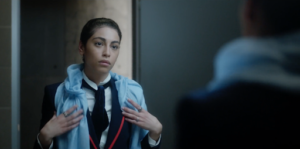
The depicted scene portrays Nadia gazing into a mirror as she removes her scarf, her expression reflecting sadness and disorientation. Mirrors and their reflections in film often symbolise various themes, including identity and self-perception (Cabrita, 2015). This scene underscores Nadia’s loss of identity, symbolised by her struggle to recognise herself, highlighting a disconnection between her inner self and outward appearance. This scene exemplifies Nadia’s opposition to assimilation being driven by personal motivations and her desire to maintain her identity as a Muslim woman externally. This is evident throughout S1 due to her conscious adherence of hijab regulations beyond school and home settings, her refusal to consume substances, as well as her reluctance to intimately engage with Guzmán despite mutual attraction.
Azucena, the headteacher, dismissing Nadia’s argument regarding the school uniform demonstrates the show’s consciousness of Western hypocrisy and the challenges confronted by Muslim women in Western societies. This awareness is particularly evident when delving into Nadia’s fetishisation. This occurs due to Lucrecia’s animosity towards Nadia, manifested when she persuades Guzmán to sexually engage with Nadia to humiliate her and undermine her confidence.
Lucrecia: Oh, sweetie. The idea of making a virginal Muslim girl fall for you doesn’t turn you on?
[S1, E2, 36:43]
The pre-modified noun “virginal Muslim girl” and the accompanying rhetorical question acknowledge the entrenched cultural discourses that constrain and objectify Muslim women as sexualised and fetishised ‘Others’ (Ahmed, 2016, pg. 49). Guzmán’s failure to challenge this sexualisation and his compliance with Lucrecia’s scheme further underscore this prevailing dynamic and issue.
The initial recognition however loses its potency as the series progresses, presenting Nadia’s assimilation as a desirable transition and perpetuating the sexualisation of Muslim women. The former is represented in S2 but is nevertheless justified in S1, notwithstanding Nadia’s persistent resistance to assimilation. This is shown when the series contradicts the initial assertion that Nadia’s resistance doesn’t stem from personal agency but arises from her adherence to her father’s, Yusef, expectations. An overt demonstration of this is Yusuf stating he doesn’t want Nadia to emulate her Western peers.
Yusuf: […] I don’t want those people to change you, Nadia
[S1, E2, 45:06]
Don’t let them change you, Nadia
[S1, E4, 17:05]
This is framed as oppression that impedes her maturation and assimilation which prevents acceptance from her Western peers. Additionally, this can be interpreted as Yusuf enforcing the dichotomy between ‘us’ and ‘them’, wherein her Western peers incur Othering. Despite her peers labelling Nadia as a ‘fundamentalist’ and ‘Taliban girl’, they are not censured for perpetuating Othering (Weernink, 2021, pg. 52), as Nadia ultimately gains acceptance through assimilation. Conversely, Yusuf is portrayed as regressive for impeding Nadia’s assimilation and ultimately has to accept her eventual Westernisation.
During S1, Nadia’s immaturity is visually manifested through her sartorial choices and appearance. Weernink (pg. 43) contends that this is underscored by her preference for “skin-covering and unobtrusive clothing,” characterised by floral patterns and soft colours reminiscent of childishness.

[S1 E1 10:54]
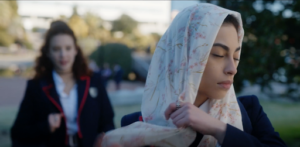
[S1 E1 28:15]
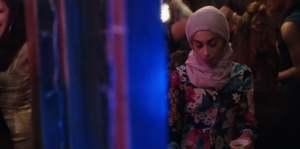
[S1 E3 20:43]

[S1 E1 04:12]

[S1 E1 06:10]
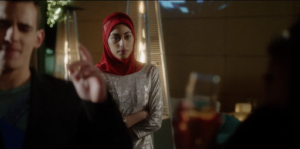
[S1 E1 35:37]
As seen above, her exclusion is discerned in several instances where she is depicted as often backgrounded and overlapped by her classmates. This is further evidenced by her uncomfortable body language, exemplified by the act of crossing her arms (Weernink, pg. 43). It is noteworthy to recognise that Nadia is often obscured and marginalised even in familial contexts. However, her placement in these contexts serves to underscore her oppressive position (pg. 37).

[Figure 1: S1 E4 10:35]
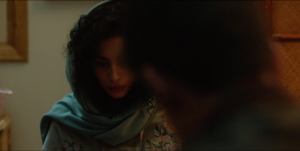
[Figure 2: S1 E4 10:55]
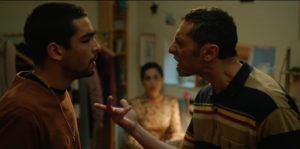
[Figure 3: S1 E8 04:53]
In the examples above, a high-angle shot is utilised, potentially indicating her inferiority, weakness, and susceptibility (Barsam & Monahan, 2018, pg. 210). Coupled with Nadia being marginalised amidst her male counterparts and her exclusion from conversations, her subjugation is further accentuated. As depicted in Figure 1, the scene portrays Yusuf demanding that she wears her hijab, reinforcing the narrative that her adherence to the hijab is not driven by personal volition. Figure 3 illustrates Yusuf prohibiting Nadia from attending a party, exemplifying Nadia’s passive demeanour as she refrains from asserting her desires to Yusuf (Weernink, pg. 37). Nadia representation as passive and silent in these contexts can be construed as evidence that Muslim women are subservient victims of Muslim men and Islam. Her oppression intensifies as S1 progresses, particularly when Yusef attempts to remove her from schooling due to her association with Guzmán. In E8, Guzmán’s intervention to sway Yusef’s decision serves as a prime example of his recurring embodiment of the White Saviour archetype. Spivak’s observation (1988, pg. 296) regarding “white men saving brown women from brown men” encapsulates the patronising attitude prevalent among many Westerners toward Muslims. The series’ portrayal of this theme contributes to the perpetuation of negative discourse surrounding Muslims. Additionally, it reinforces the narrative that portrays Muslim women as passive victims reliant on the liberation efforts of white individuals, depicts Muslim men as misogynists, and characterises Islam as a patriarchal religion (Bjoernaas, 2015, pg. 80).
As previously mentioned, Nadia’s oppression catalyses her integration into Western culture, a transformation that abruptly occurs in S2.
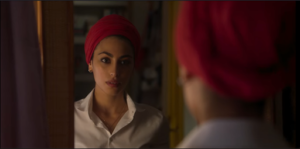
[S2 E1 05:31]

[S2 E1 15:50]
This evolution is initially manifested in her outward presentation, which undergoes a marked contrast from her appearance in S1. Upon her first S2 appearance, she is wearing makeup, a red hijab styled like a turban that reveals her skin, and jewellery. These changes already signify a shift towards adult femininity (Hämäläinen et al, pg. 8), diverging from the childlike femininity she displayed in S1.
Within the episode, Nadia also exhibits behavioural shifts that align with Western cultural inclinations.
Nadia: I’m going
Samuel: You? You’re willing to go to a club?
Nadia: Why not?
[S2 E1 17:03]
Notwithstanding Nadia’s attendance at parties during S1, Samuel’s questions convey incredulity, emphasising Nadia’s deviating from her customary conduct. This marks the beginning of her involvement in nightlife and her further assimilation into Western culture, as she progressively adopts the behaviours of her Western peers (Weernink, pg. 44). Consequently, her sartorial and behavioural changes become increasingly conspicuous.
Subsequently, in a later scene, Nadia exemplifies these changes by removing her hijab at the club under the influence of her newfound friend, Rebeka.
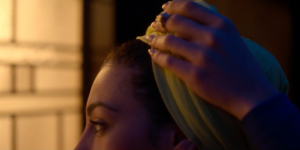
[S2 E1 26:14]

[S2 E1 26:16]
This scene contrasts significantly with her depiction in S1, wherein she ardently defended her Muslim identity and consistently upheld it whenever possible. By allowing Rebeka remove her hijab only further perpetuates the notion that her adherence to the hijab was not voluntary. Additionally, it reinforces the notion suggesting that there is a perceived dependence of Muslim women on the liberation efforts facilitated by white women to attain agency (Bjoernaas, pg. 79).
Though deviating from Islamic doctrine, the removal of her hijab is framed positively, reflecting her changing identity and growing empowerment (Weernink, pg. 33).
This is visually depicted through the utilisation of a medium shot, framing Nadia from the waist up and making her large enough in the frame to reduce the background to insignificance, thus placing her at the forefront of the shot (Barsam and Monahan, pg. 207).
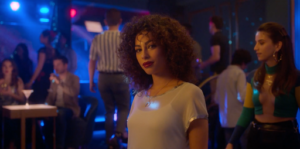
[S2 E1 26:46]
Barsam and Monahan assert that a medium shot allows viewers to observe the physical details of the increasingly dominant subject. This framing choice likely functions to accentuate her face, body language, exposed hair and skin. Addressing the former aspects, Nadia engages in prolonged eye contact with Guzmán while subtly smiling. This bears significance as these nonverbal cues are commonly associated with female flirtation (Sheldon and Tisdale, 2018, pg. 4). Considering her inclination to maintain distance from Guzmán in S1, this marks another one of her behavioural changes. When acknowledging the additional details, it is evident that unveiling herself contributed to her flirtatiousness. This indicates that her previous adherence to the hijab impeded her from expressing her desires.
Recognising Islam’s mandate of the hijab as a measure to protect women from sexualisation (Hasan, 2017), it can be asserted that the decision to unveil Nadia deliberately serves to subject her to sexualisation. By unveiling her, it can be perceived to dismantle her resistance and render her available for conquest (Fanon, 1967, pg. 43). While seemingly trivial, the aggregation of subsequent events and factors substantiate this assertion. The first event is her flirtation escalating to the point where she initiates kisses with Guzmán, another form of flirtation, that signifies the onset of her sexual development (Sheldon and Tisdale, pg. 4).

[S2 E3 44:34]
The subsequent occurrence involves, despite being a dream, the vivid depiction of Nadia in a sexual context.

[S2 E4 00:26]

[S2 E4 00:30]
Nadia being in red, coupled with the illumination of red lighting, serves to accentuate her sexualisation. This interpretation derives from the societal association of red with female sexual receptivity, a motif recurrent in mythology, folklore, and literature, where red symbolises sexual promiscuity and availability (Elliot et al, 2012, pg. 787). The deliberate use of lighting and colour in this context may also serve to elicit viewer attraction towards Nadia, given research indicating red’s capacity to stimulate sexual attraction in men towards women (pg. 789-790). Moreover, the employment of a medium close-up shot, capturing Nadia from chest to head, appears to serve a dual purpose: further eliciting viewer attraction and prompting sexual fantasy. By centring on her rapturous expression, it potentially evokes viewer arousal and fantasies. The latter notion finds reinforcement in her sexual depiction within a dream sequence, indirectly reinforcing associations of the Orient or Oriental with the escapism of sexual fantasy (Said, pg. 190).
This escalates further when she does eventually initiate intercourse with Guzmán, transitioning the sexual fantasy into a tangible reality within the storyline.

[S2 E4 37:55]
Given that these encounters are extraneous to the series narrative, they lack any discernible purpose aside from providing titillation for the viewer (Robbins, 2023). Consequently, it can be inferred that her sudden sexualisation is attributed to fan service. This practice entails deliberately incorporating content into narratives to service and gratify the audience, which is often sexual in nature (Tucker, 2009, pg. 75-76; Wolk, 2007, pg. 6). Besides sexual gratification, the appeal may resonate with Fanon’s (pg. 45) assertion that intercourse with a Muslim woman is a fantasy of the Occidental, “always preceded by the rendering of the veil,” which Fanon describes as a form of double deflowering. This is substantiated by her sexual and romantic involvement with a white man.
While fan service may have attributed, it is not the initial or sole determinant of Nadia’s sexualisation, considering the first instance of her sexualisation is discerned in S1. In this instance, Nadia is spiked during a party and, under the influence, spontaneously decides to swim in Guzmán’s pool.

[S1 E3 34:28]

[S1 E3 34:35]

[S1 E3 34:48]
During this scene, Nadia is portrayed through the lens of the oversexualised siren trope, particularly evident in her literal swimming resembling a siren (Alhassen, 2018, pg. 19-20). This depiction is underscored by the emphasis on the removal of her hijab, accenting her long flowing hair, which is emblematic of siren femininity (Frojmovic, 2023, pg. 109). Moreover, Nadia embodies the imagery of sirens luring men into the sea when she seductively asks Guzman, “Are you getting in?” thereby tempting him with her elusive sexuality and beauty (pg. 109). Considering the removal of her hijab at this juncture lacks narrative or contextual relevance, it raises the possibility that it was executed to fulfil Occidental fantasies of unveiling Muslim women to showcase their beauty (Fanon, pg. 43).
Despite being involuntarily drugged, this instance marks the first occasion where Nadia ostensibly ‘voluntarily’ removes her hijab. Her subsequent conduct also indicates the notion that being ‘free’ is associated with deviating from Islamic doctrine. As discussed, this notion is further emphasised and substantiated in S2, where she progressively indulges in alcohol, unveils herself, and engages in sexual activities, all seemingly contributing to her perceived ‘liberation’. By portraying her sole acts of freedom as contingent upon engaging in these behaviours, the narrative perpetuates the idea that the ultimate expression of postfeminist freedom, autonomy, and empowerment aligns with a Western perspective (Weernink, pg. 45). Moreover, it implies that Muslim women could “ascend to the haloed liberal, secular universe of human rights” where displayed skin and flaunted sexuality is considered a measure of a woman’s freedom and equality (Sarkar, 2017, pg. 245). This argument gains credence when considering the series’ failure to acknowledge that, for many Muslim women, the hijab represents a form of freedom and liberation, particularly from sexual objectification (Meetoo and Mirza, 2018, pg. 230).
While this narrative trajectory may seem exclusive to Elite, Nadia’s transformation from a submissive Muslim girl to a Westernised empowered woman precisely encapsulates the two predominant stereotypical depictions of Muslim women in Western media (Navarro, 2010, pg. 99). However, it is plausible to interpret Nadia’s character arc as a guise simply to perpetually possess the perceived reality of veiled women and “render them visible for the gaze always” (Bullock, 2000, pg. 11). With the hijab serving as a barrier to the possession of Muslim women by men and colonists, Fanon (pg. 44) argues that encountering Muslim women who “see without being seen” incites frustration among them. Consequently, there is a desire to unveil the Muslim woman, especially visually, to bring her within reach and objectify her. This notion gains further traction from S2 onwards, where Nadia is unveiled more frequently, aligning with similar portrayals in other Western entertainment. Examples include Ackley Bridge (2017-2018), The Princess and the Marine (2001), and Never Have I Ever (2020-2023), where Muslim women are consistently unveiled and adopt Western practices over Islamic ones.
Irrespective of whether Nadia’s portrayal was motivated by fan service, depicting Muslim women in this manner invalidates their agency and perpetuates the fetishisation and exoticisation of Muslim women, phenomena historically rooted in colonialism (Aguilera-Carnerero and Tegal, 2023, pg. 213). Furthermore, depicting them as willingly assimilating due to ostensible oppression and subjugation reinforces Islamophobia as a self-justifying phenomenon (Bjoernaas, pg. 80).
2 | The Expected Assimilation of Muslim Men
While the anticipated assimilation of Muslim women is more apparent, a form of assimilation, besides participation in hook-up and drinking customs, expected among Muslim men is not as conspicuous, possibly due to its recent or covert nature. The prevailing form of assimilation projected for Muslim men revolves around adopting contemporary Western masculinity, thereby incorporating elements of feminisation.
It is crucial to emphasise that conventional societal expectations regarding masculinity play a significant role in conditioning men to express strength and dominance, especially in relation to others. This conditioning inherently dictates that men should embody traits such as stoicism, independence, toughness, and power. Nevertheless, it is important to recognise that the concept of masculinity is not static; rather, it has continuously evolved in response to shifts in societal and cultural dynamics (Connor et al., 2021, pg. 1-2). The pertinent transformation in this context involves men becoming more attuned to their emotions and adopting traditionally considered ‘feminine’ traits, a response to evolving economic conditions and the emergence of feminism in the late twentieth and early twenty-first centuries (Copland, 2023, pg. 123).
Nevertheless, the conventional notion of emotional sensitivity being associated with femininity does not apply or align with the construct of Islamic masculinity, as men are religiously mandated to embody traits of ‘softness’ and ‘openness’ (Khan, 2018, pg. 65). Therefore, the concept of gender, which now encompasses “any array of traits between the extremities of masculinity and femininity” (Hjort & Komulainen, 2017, pg. 1), such as men wearing makeup, will predominantly be later applied.
This concept of Western masculinity diverges from the one presented in Islamic doctrine, wherein Islamic sharia underscores a distinct division between sexes and requires “men to assume full virility and women to assume full femininity” (Shehab, 2014, pg. 25).
Nevertheless, within contemporary Western entertainment media, a discernible pattern emerges wherein Muslim men are increasingly portrayed with effeminate attributes or undergo a process of feminisation, often influenced by embracing homosexuality into their identity.
Akin to Nadia, the sole rationale behind his deviation from Islamic norms is to assert the idea that Omar experiences oppression due to his adherence to Islamic regulations imposed by Yusef. Where his distinction lies in the fact that conforming to Islamic norms causes his depression, contrasting with the embrace of Western ideals. Nonetheless, Omar’s experience of oppression diverges from Nadia’s, as he experiences oppressive tropes and stereotypes associated with or encountered by Muslim women. An instance of such a trope applied to Omar is the extreme scenario of a father hindering his daughter from leaving the household (Eli-Ali, 2021, pg. 108). This is first indicated when Ander, Omar’s significant other, confronts him regarding his involvement in drug distribution and the potential consequences of imprisonment.
Omar: I already live in a fucking jail. This! This dough will set me free. I need it to leave home.
[S1, E6, 07:10]
Nevertheless, at this juncture in the series, Omar’s domestic confinement remains tentative, as he is primarily assisting with his family’s business affairs. Therefore, his assertion that his home is a prison is purely metaphoric. However, the inception of his oppression is not confined to this moment but rather discernible through clues dispersed before this point, intertwined with maintaining his parents’ satisfaction by concealing his queerness. An example of this, which also reinforces the affirmation of his femininity occurs when he emotionally expresses to Ander his inability to pursue a relationship with him.
Omar: Because I can’t do this. Too many people know about it. Even my sister, man. And you don’t know my family. If they found out, the disappointment would kill them.
[S1 E5 35:52]
This observation holds significance as it aligns with Elfving-Hwang’s (2010, pg. 68) assertion that women, within numerous patriarchal societies, encounter the expectation to be willing sacrifice their personal or sexual aspirations for the collective welfare of the family.
A visual manifestation of his oppression occurs when his parents, off-screen, become aware of Omar’s involvement in drug dealing.
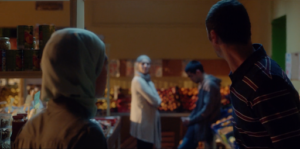
[S1 E6 34:47]
The store is enveloped in darkness, with the sole illumination emanating from the streetlights outside. The subdued lighting contributes to the creation of a visually oppressive ambience. His subjugation is additionally accentuated by his mother who is positioned between the sole light source and Omar. Consequently, she casts a shadow over Omar, enveloping him in deeper darkness. It is additionally exemplified through his insecure body language, characterised by a bent back and a lowered head (Kaganovsky, 2012, pg. 169).
In parallel with the visual portrayal of Nadia’s oppression, Omar’s oppressive state is underscored by his placement in the backgrounded and being overlapped by Nadia and their father in the frame. This effect is heightened notably as he is excluded from the ongoing conversation.
During his discussion with Nadia, Yusef discovers that Nadia was previously out with Guzmán. His demeanour becomes more aggressive marked by an intensification in tone, ultimately leading to a violent outburst where he strikes a shelf. This incident marks the first occurrence of Yusef’s violent behaviour, captured vividly through a close-up shot of Omar’s face.
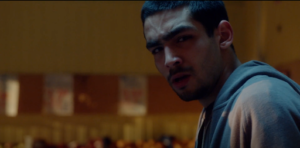
[S1 E6 35:15]
The function of this close-up is active, as it comments on Yusef’s actions and words, and reveals Omar’s apprehension (Barsam & Monahan, pg. 271).
Yusuf: It’s my fault. It’s my fault! Too much freedom! But it’s over!
His words are directed towards both Nadia and Omar. This portrayal perpetuates stereotypes of Muslims as regressive and prone to violence (Senanayake, pg. 67), as well as reinforcing the stereotype of Muslim men as inherently oppressive to women (Bhatti, 2021, pg. 13).
As Yusef’s oppressiveness extends to Omar, it results in Omar’s confinement at home being deliberate and restrictive, aimed at preventing his assimilation. Consequently, this confines Omar within the stereotype of a Muslim daughter constrained within the household by her father, thereby feminising him. The extent and solidification of this confinement is established later into the episode when Ander visits the family store.
Ander: Why don’t you answer my messages?
Omar: I don’t have a cell anymore.
Ander: When can we meet?
Omar: I’ll be behind this counter for two years.
[S1, E6, 44:14]
Despite Ander’s earnest plea, Omar rejects him. It merits attention that a closed frame technique is employed during this scene, as shown below. As elucidated by Barsam and Monahan (pg. 220), a closed frame is strategically utilised to suggest that external influences have constrained the characters’ autonomy and ability to move and act freely. In this instance, these external forces manifest as paternal and religious expectations. The former impedes Omar from leaving the store and household, while both the former and the latter constrain him from embracing his sexual orientation openly. This constraint is palpable in the closed frame as Omar continually shifts his gaze between Ander and Yusuf, apprehensive of potential discovery.
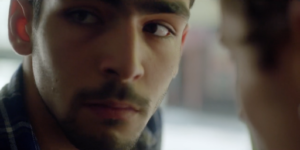
[S1 E6 44:48]
Another conventional stereotype applied to Omar is the notion of Muslim girls being perceived as victims of coerced marriage (Bjoernaas, pg. 80). This perception of oppression becomes apparent when Yusef reintroduces Nasser and Fatima to Omar. Yusef mentions to Omar that they have a daughter, Zahira, who is Omar’s age.

[S1 E7 13:26]

[S1 E7 13:27]
After this scene, Yusef shifts his focus towards Nasser and Fatima, extending an invitation for tea along with their daughter, which they mutually accept. Omar is conspicuously absent from the shot, with an over-the-shoulder shot established, indicating his exclusion from the discourse.

[S1 E7 13:30]
This sense of exclusion becomes more pronounced as Omar, heard off-screen, attempts to excuse himself from the gathering.
01 Yusef: Why don’t you come for tea on Wednesday and bring her along?
02 Omar: I don’t know if I can on Wednesday
03 Yusef: You have something better to do than meet your future wife?
The clear intent and implication of arranging Omar’s marriage is now solidified in line 3. The employment of the adjective ‘future’ coupled with the noun ‘wife’ inherently precludes any potential negotiation, a point accentuated by Omar’s nonresponse to the inquiry. While Yusef may have framed the question rhetorically, perhaps anticipating an implicit admission of agreement from Omar (Enzle & Harvey, 1982, pg. 172), this possibility only serves to underscore Omar’s lack of agency in the decision-making process. It is also evident that Yusef is not oblivious to Omar’s reservations about the meeting, as Omar’s visible apprehension is not exclusively apparent to the viewer but also to Nasser, who jests to Yusef: “[…] don’t rush him. We don’t want him looking that scared when we introduce them.” Yusef’s response, characterised by laughter, dismisses Omar’s fear and desire not to marry.

[S1 E7 13:40]
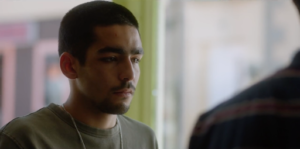
[S1 E7 13:49]

[S1 E7 13:50]
This provides Ander a foundation upon which he endeavours to save Omar from the constraints of his oppressive circumstances. Considering the feminine nature of Omar’s oppression by his father, alongside Ander’s identity as a white male, Spivak’s assertion (pg. 101) regarding white men seeking to rescue brown women from brown men can also be extended to Omar’s situation. Here, Omar assumes the role traditionally associated with the feminine, necessitating rescue.
As a means of assimilation, the process of feminising Omar within the show primarily revolves around his sexuality and the role he assumes in his relationship with Ander. A small-scale illustration of the former is depicted as Omar, embracing his sexuality, becomes socially feminine. This transformation seemingly stems from his engagement in platonic interactions with women after leaving his Muslim household. It should be noted that within Islamic teachings, the mingling of sexes is prohibited due to the belief that it will result in detrimental consequences, notably the feminisation of men (Shehab, 2014, pg. 133), a phenomenon seemingly exemplified by Omar.
The first manifestation of this occurs when Omar discusses his interest in grooming his eyebrows and personal appearance with Lucrecia.
Omar: I’m thinking of changing em’ up a bit. Giving them a little trim. Maybe a piercing? We’ll see.
[S2 E4 30:54]
While seemingly inconsequential, the inclination towards grooming and personal appearance is commonly associated with femininity (Hjort & Komulainen, 2017, pg. 1), and his social femininity becomes more pronounced henceforth.
For instance, Omar prepares for a Halloween party by adorning the guise of “the fabulous transvestite, Frank-N-Furter” (Karlovich, 2015, pg. 167) in The Rocky Horror Picture Show (1975). Initially, Omar’s costume comprises a suspender belt paired with stockings, a sequined halter top, heels, elbow-length gloves, a wig, eccentric makeup, and a pearl necklace, resembling a femme fatale.
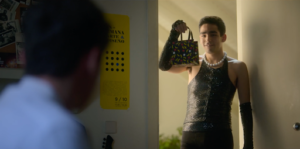
[S2 E5 18:20]
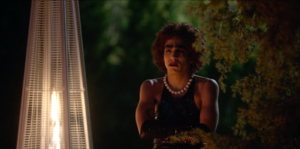
[S2 E5 32:12]
It is noteworthy that at this juncture in the series, Omar is devoid of facial hair. This observation carries weight due to Islamic principles that dictate the wearing of a beard. The principal function of the beard is to delineate Muslims from non-Muslims, while also serving to uphold and distinguish masculinity from femininity (Fudge, 2019, pg. 103-105). Consequently, the act of shaving one’s beard is associated with effeminacy and imitates the appearance of “unbelievers and polytheists” (pg. 112-113). While shaving his beard represents one form of deviation from Islam, Omar undergoes extreme deviation by committing flamboyant transvestism for Halloween, a secular western holiday that is not sanctioned within Islam (Yousaf, 2021, pg. 88).
Although this was an isolated occurrence, Omar’s lexicon adopts more feminine characteristics.
01 Omar: Hmm, honey, you’re really throwing ‘em back.
02 Ander: Honey?
[…]
03 Rebe: Hey, you big Queen!
04 Omar: Would you look what the cat dragged in! Mwah! ((pecks Rebe’s lips))
[…]
05 Omar: […] then you better tell me all about it, girl. But first, you aren’t gonna say anything?
06 Rebe: You look gorgeous. Like a goddess.
[S2, E6, 19:53]
Exclusively based on vocative expressions employed by Omar, such as ‘honey’ (l.01) and ‘girl’ (l.05), it is reasonable to contend that Omar is embracing a more feminine persona. While ‘honey’ and ‘girl’ are not exclusive to either gender, they predominantly carry feminine connotations, with ‘honey’ often used by females to address their partners and ‘girl’ used by girls to address one another. This assertion gains traction when considering Omar’s acceptance of the vocative expression ‘Queen’ (l.03) and invitation of the adjective ‘gorgeous’ (l.06), and the simile ‘like a goddess’ (l.06) applied by Rebe. His flamboyant behaviour, demonstrated through transvestism and exaggeratedly kissing Rebe (l.04), only reinforces his effeminate transition.
Elite further accentuates his feminisation through his gender role orientation within his relationship with Ander, especially within their sexual dynamic. Specifically, Ander typically assumes the dominant position in sexual encounters with Omar. According to Burke (2016, pg. 134), contemporary Western culture often emphasises a sexual narrative where men traditionally take on the role of penetrators, exerting dominance over women. Within this framework, women are relegated to the submissive role, receiving penetration. Applying the stereotype equating masculinity or topping with dominance, and femininity or bottoming with submission (Santor, 2016, pg. 1-2), Omar’s usual role as the recipient of sodomy aligns him with the feminine and submissive role. This assertion is reinforced by the notion that homosexual men are perceived as feminine because they consent to being penetrated and dominated (pg. 2).
Even when penetration is not involved, Omar’s perceived femininity remains discernible. Instances where Omar kneels on both knees during fellatio, merit examination. Although the feminine connotations of kneeling remain debatable, discourse identifies kneeling as a trait associated with submission (Moser & Kleinplatz, 2007, pg. 48). Given that submissiveness is emphasised in discourses surrounding femininity (Elfving-Hwang, pg. 44), Omar’s act of kneeling could be construed as an expression of femininity within the relational context.

[S3 E1 07:22]
The camera angle serves to underscore Omar’s comparative submissiveness to Ander, as it employs a high angle shot where the camera looks down upon Omar (Barsam and Nonahan, pg. 210). Coupled with an over-the-shoulder shot from Anders’ perspective, where Ander and the camera gaze downward at Omar, viewers are positioned to regard Omar from a vantage point of superiority, thus implicitly casting him as inferior. This depiction aligns with the common association of femininity with inferiority (Elfving-Hwang, pg. 65).
Ander’s perceived superiority may stem from his embodiment of more conventional masculine traits compared to Omar. Given the prevalent equation of femininity with inferiority, it could be argued that masculinity corresponds to superiority. A notable illustration of this is Omar’s disinterest in soccer and his lack of engagement in sports throughout the series, in contrast to Ander, who is portrayed as a skilled and accomplished athlete. This discrepancy highlights the divergence in masculinity between Ander and Omar, echoing Swain’s (2006, pg. 1) assertion that “being sporty […] is a significant indicator of successful masculinity.”
His superiority may predominantly derive from his embodiment of the White Saviour. This notion is underscored by Ander giving Omar agency to claim his autonomy, and housing him when he becomes estranged from his family (Abdullah & Nasir, 2021, pg. 44). While the rationale behind Omar’s adoption of femininity aims to normalise and potentially encourage assimilation among Muslim men, the inclusion of the White Saviour narrative suggests a dual purpose. This dual purpose could be to uphold the depiction of the Orient as “aberrant, undeveloped, inferior” in contrast to the West’s portrayal as “rational, humane, superior” (Said, pg. 300). The former assertion is chiefly reinforced by Yusef’s characterisation as a ‘dictator,’ which connotes excessive politicisation, a term that serves as a critique of Islam for its perceived lack of liberalism (Said, pg. 299). This rationale justifies Omar’s assimilation, while his adoption of a feminine persona and sexual submission to Ander perpetuates the notion that the Orient is “passive, seminal, feminine […] and supine” (pg. 138).
While this argument may not appear robust or limited to one instance, these themes pervade Western media. For instance, characters such as Syed in Eastenders (1985-) and Kash in Shameless (2011) exemplify this trend. Though there are variations, the shared theme among these three characters involves feeling constrained and oppressed by religious expectations, undergoing sexual submission to their white male partners, and ultimately leaving their religious household to embrace Western values.
This portrayal could be interpreted as an attempt to undermine the masculinity of Muslim men, possibly stemming from concerns about Muslim dominance in the Western or envy towards the perceived resilience of Muslim masculinity compared to that of Western men. Brenton Tarrant, the Christchurch shooter, articulated a similar perspective addressed by Copland (pg. 125-128). Tarrant argues that Western men are becoming weaker due to feminisation, thereby allowing Muslims to replace them. He contends that “there is a growing difference between Western and Muslim men, with Muslim men maintaining the strength that he desires to see in the West” (pg. 127).
Tarrant also addresses the idea of Muslims assimilating into Western culture (pg. 127-128):
Expecting immigrants to assimilate to a dying, decadent culture is laughable. Who would willing (sic) leave their own strong, dominant and rising culture to join an elderly, decaying, degenerate culture? What culture would entice a man, one of traditions, beauty, architecture, art and prosperity, to a culture of decay, self-hatred, childlessness, disorder and nihilism?
This narrative contradicts the Western portrayal of Muslim men, wherein they are depicted as willingly assimilating into Western society, citing oppression within Islamic doctrine as the driving force behind this assimilation, as opposed to Western culture and the tenets of liberalism.
To consistently represent Muslims as oppressed, weak, or feminine and Islam as oppressive, is to maintain and reestablish the idea of a superior West.
Conclusion
The preceding chapters of this study have examined the anticipated assimilation of Muslim men and women as portrayed in Elite, alongside an exploration of the underlying functions inherent in Nadia and Omar’s depictions of assimilation.
In summary, Muslim women are predominantly expected to assimilate by unveiling themselves and adopting Western fashion, while Muslim men are anticipated to forsake Islamic masculinity in favour of adopting Westernised masculinity, thus appearing more effeminate. However, the analysis also asserts additional factors contribute to their representations beyond merely reflecting societal expectations.
In the case of Nadia, her assimilation appears to serve the function of sexualising her and conforming to Western fantasies. Conversely, the extreme feminisation of Omar implies a function aimed at undermining Islamic masculinity and perpetuating the notion of a passive and submissive Orient. Furthermore, the sexual encounters with white men by both characters, who embody the White Savior trope, seemingly reinforce the narrative of Muslim inferiority and underdevelopment compared to the ostensibly rational and superior West. This contention is substantiated by the observation that their assimilation is preceded by the vilification of Islam and its tenets. As discussed in the preceding chapters, this phenomenon is not exclusive to Elite but is ubiquitous in Western film.
Beyond the implication of ulterior motives, Elite also exhibits hypocrisy and double standards reflective of Western society. One instance is Nadia perceiving herself as superior to those who dress provocatively. This contradicts the prevailing societal discourse, which tends to stigmatise veiled Muslim women, often perceiving them as inferior (Piela, 2022; Alexander, 2016, pg. 4).
Lucrecia: […] Wearing a scarf on your head makes you superior to us?”
[S1 E1 36:43]
Marina: So, you’re free to wear a scarf, but I can’t take my clothes off?
[S1 E3 20:06]
Perhaps the most prominent demonstration of hypocrisy evident in Elite, reflecting Western societal norms, is the imposition of Western values and practices on Nadia and Omar, without a reciprocal application of Islamic values or practices. Specifically, non-Muslim characters are notably devoid of adopting Islamic norms. This pattern extends across Western media, suggesting a pervasive asymmetry. This asymmetrical treatment may stem from the perpetuation of the notion of the West’s ideological superiority.
While it can be contended that this expectation applies solely to Muslims residing in Western societies, the expectation of Muslims adopting or assimilating to Western practices also extends to individuals living in Muslim-majority countries. This notion finds alignment with Huntington’s (1996, pg. 28) assertion that the Western world perceives its ideology and culture as something that should be universal.
A recent example of this occurred during the 2022 World Cup hosted by Qatar. Despite the expectation of Muslims to adhere to Western customs and practices when in Western societies, Westerners did not adhere to this same standard while in Qatar. Evidence of this was seen in Westerners promoting LGBTQ+ symbols and disregarding dress codes, with extreme cases involving toplessness (Kraterou, 2022; Sommerland, 2022). These actions appeared to be aimed at defying Qatari Islamic customs and imposing Western values and practices.
As noted in the introduction, there has been a recent surge in portraying Muslims with greater complexity, as evidenced by several films featuring positive depictions of Muslims without necessarily portraying them as assimilating (Gentry, pg. 54).
Recent examples include Ali from Euphoria (2019-), Hassan from Midnight Mass (2021), and Nakia from Miss Marvel (2022). Despite Euphoria being replete with intercourse and drug use, Ali is depicted as a recovering alcoholic and former drug user who has embraced Islam. He serves as a calm and nurturing presence, aiding the protagonist in her recovery while adhering to Islamic principles to protect himself from Western influences and relasping. Similarly, Hassan, the lone Muslim in a Christian community in Midnight Mass, steadfastly maintains his faith and practices without compromise, showcasing a proud adherence to his religion. These portrayals stand in stark contrast to the stereotypical depiction of Muslim men as misogynistic and violent individuals who indulge in debauchery under the guise of Western liberation.
In Miss Marvel, Nakia defies the conventional narrative of the submissive Muslim girl who finds empowerment through unveiling and Westernisation. Instead, her empowerment stems from wearing the hijab, challenging stereotypes and highlighting the diverse experiences of Muslim women.
As noted by Gentry (pg. 69), if mainstream media can propagate Islamophobia and misconceptions, then it is equally plausible for these alternative narratives to counteract such messaging. Nevertheless, despite the evolving portrayal of Muslims and Islam in media, substantial reforms are still needed to dismantle the prejudices perpetuated by past cinematic representations (Senanayake, pg. 67). To achieve this, the depiction of Western assimilation as a desirable transition for Muslims, particularly when preceded by vilifying Islam and its followers, must stop. Such portrayals contribute to the perception of Islam as an oppressive religion, justify Islamophobia, diminish the experiences of content Muslims, and reinforce the notion that Muslims require Western ideological frameworks.
Bibliography
Abdullah, S., & Nasir, A. (2021). White Saviour Complex and (Mis)Portrayal of Blacks in Kathryn Stockett’s ‘The Help’. In: Journal of Research (Humanities), Vol. 57(1). University of the Punjab, 43-56.
Aguilera-Carnerero, C., and Tegal, M. (2023). Multimodal Islamophobia: Gendered stereotypes in memes. In: Journal of Arab & Muslim Media Research, Vol. 16(2). Intellect Limited, 201-222.
Ahmed, Fauzia (2016). Do young British Muslim women need saving?. In: Sadek, H (eds) Young British Muslims: Between Rhetoric and Realities. Taylor & Francis.
Ahmed, S., and Mattes, J. (2017). Media representation of Muslims and Islam from 2000 to 2015: A meta-analysis. In: International Communication Gazette, Vol. 79(3). Sage Journals, 219-244.
Alexander, Claire (2016). The Motivations Behind Westerners’ Obsession with the Islamic Veil. In: What All Americans Should Know about Women in the Muslim World. The Cupola.
Alhassen, Maytha (2018). Haqq & Hollywood: Illuminating 100 years of Muslim Tropes and How to Transform them. Pop Culture Collaborative.
Ali, Bisha (2022). Miss Marvel. Marvel.
Aziz, Sahar (2015). Coercing Assimilation: The Case of Muslim Women of Color. In: Transnational Law & Contemporary Problems, Vol. 24. University of Iowa College of Law, 341-351.
Barsam, R., & Monahan, D. (2018). Looking at Movies. W.W. Norton.
Batres, C., Courrèges, S., Kaminski., G., Morizot, F., Porcheron., A., Russell, R., and Soppelsa, F. (2018). Differential effects of makeup on perceived age. In: British Journal of Psychology, Vol. 110(3). ResearchGate. Available from: https://www.researchgate.net/publication/326812073_Differential_effects_of_makeup_on_perceived_age
Bhatti, Tabetha (2021). Defining Islamophobia: A Contemporary Understanding of How Expressions of Muslimness are Targeted. Muslim Council of Britain.
Bianco, P., Frizzell, A., Levinson, S., and Morrison, J. (2019). Euphoria. HBO.
Bjoernaas, Therese (2015). Saving Muslim Women: A Feminist-Postcolonial Critique of Veiling Legislation in Norway. In: Islamophobia Studies Journal, Vol. 3(1). Pluto Journals, 78-89.
Bullock, Katherine. (2000). The gaze and colonial plans for the unveiling of Muslim women. In: Studies in Contemporary Islam, Vol. 2(2). Center for Islamic Studies, 1–20.
Burke, Kelsy (2016). What Makes a Man: Making “Bad” Sex “Good.” In: Christians Under Covers. University of California Press.
Cabrita, Josh (2015). Images and Identities: Top 5 Uses of Mirror in 2015. THEYOUNGFOLKS. Available from: https://www.theyoungfolks.com/film/68334/images-and-identities-top-5-uses-of-mirrors-in-2015/
Connor, S., Edvardsson, K., Fisher, C., and Spelten, E. (2021). Perceptions and Interpretation of Contemporary Masculinities in Western Culture: A Systematic Review. Sage Journals.
Copland, Simon (2023). Weak Men and the Feminisation of Society: Locating the Ideological Glue between the Manosphere and the Far-Right. In: Goetz, Judith, & Mayer, Stefanie (eds) Global Perspectives on Anti-Feminism: Far-Right and Religious Attacks on Equality and Diversity. Edinburgh University Press, 116-136.
El-Ali, Leena (2021). No Truth Without Beauty: God, the Qur’an, and Women’s Rights. Springer International Publishing.
Elfving-Hwang, Joanna (2010). Representations of Femininity in Contemporary South Korean Women’s Literature. Brill.
Elliot, A., Greitemeyer, T., and Pazda, A. (2012). Sexy red: Perceived sexual receptivity mediates the red-attraction relation in men viewing woman. In: Journal of Experimental Social Psychology, Vol. 48(3). ScienceDirect, 787-790.
Enzle, M. E., & Harvey, M. D. (1982). Rhetorical Requests for Help. In: Social Psychology Quarterly, Vol. 45(3). American Sociological Association, 172-176.
Fanon, Frantz (1967). A Dying Colonialism. Grove Atlantic.
Flanagan, J., Flanagan, M., Gale, E., Howard, J., and Parker, D. (2021). Midnight Mass. Netflix.
Frojmovic, Eva (2023). The Siren’s Seed. In: IMAGES, Vol. 16, Issue 1. Brill, 109-128.
Fudge, Bruce (2019). The Beards of the Ancestors: From the Prophet’s Companions to the “Islamic State.” In: Fudge, B., Herzog, T., Maleh, Z., & Volokhine, Y. (eds) Barbe et barbus: symboliques, rites et pratiques du port de la barbe dans le Proche-Orient ancien et moderne. Peter Lang, 103-117.
Gentry, Brooke (2018). From Antagonists to Protagonists: Muslims on the Hollywood Screen. Digital Commons @ Colby.
Hämäläinen, A., Kolesnikov, V., Komulainen, K., Räty, H., and Skorokhodova, N. (2011). A picture is worth a thousand words: a comparison of pupils’ images of intelligence in Finnish and Russian Karelia. In: Social Psychology of Education, Vol. 14. SpringerLink, 1-22. Available from: https://link.springer.com/article/10.1007/s11218-010-9137-8#citeas
Haron, H., Jamil, N.N., and Ramli, N.M. (2020). WESTERN AND ISLAMIC VALUES AND ETHICS: ARE THEY DIFFERENT?. In: Journal of Governance and Integrity, Vol. 4(1). Penerbit UMP Press, 12-18.
Hasan, Aisha (2017). We need to talk about the sexualisation of Muslim women. The Qarawiyyin Project. Available from: https://qarawiyyinproject.co/2017/07/27/we-need-to-talk-about-the-sexualisation-of-muslim-women/
Hjort, M., & Komulainen, V. (2017). Men in Makeup: Performances of gender transgression in male beauty vloggers’ makeup consumption. Lund University Publications.
Hofstra University (no date). Women and the Islamic Veil: Deconstructing implications of orientalism, state, and feminism through an understanding of performativity, cultivation of piety and identity, and fashion. Hofstra University.
Hughes, G.F. (2017). The Chastity Society: disciplining Muslim men. In: The Journal of the Royal Anthropological Institute, Vol. 23(2). Royal Anthropological Institute of Great Britain and Ireland, 267-284.
Huntington, Samuel (1996). The West Unique, Not Universal. In: Foreign Affairs, Vol. 75(6). JSTOR, 28-46.
Kaganovsky, Lilya (2012). Review of The Factory of Gestures: Body Language in Film. In: Cinema Journal, Vol. 51(3). University of Texas Press, 168-170.
Karlovich, Alycia (2015). 30% FEMALE, 70% MALE, 100% TRANSYLVANIAN. Mercer Street.
Khan, Arsalan (2018). Pious Masculinity, Ethical Reflexivity, and Moral Order in an Islamic Piety Movement in Pakistan. In: Anthropological Quarterly, Vol. 91(1). JSTOR, 53-77.
Kraterou, Aliki (2022). NAKED FURY Topless Argentina fan reveals REAL reason behind World Cup stunt after vid shows her being ‘kicked off’ Qatar beach. The Irish Sun. Available from: https://www.thesun.ie/sport/football/9948139/topless-argentina-fan-reason-world-cup-kicked-qatar-beach/
Meetoo, V., and Mirza, H. S. (2018). Empowering Muslim girls? Postfeminism, multiculturalism and the production of the ‘model’ Muslim female student in British schools. In: British Journal of
Sociology of Education, Vol. 39(2). Taylor & Francis, 227-241.
Montero, C. and Madrona, D. (2018). Elite. Spain: Zeta Audiovisual, Atres media. Available on: Netflix.
Moser, C., & Kleinplatz, P.J. (2007). Themes of SM expression. In: Barker, M., & Langdridge, D. (eds) Safe, Sane, and Consensual: Contemporary Perspectives on Sadomasochism. Palgrave Macmillian, 35-54.
Navarro, Laura (2010). Islamophobia and sexism: Muslim women in the western mass media. In: Human Architecture: Journal of the Sociology of Self-Knowledge, Vol. 8(2). Ahead Publishing House, 95-114.
Piela, Anna (2022). Muslim Women and the Politics of the Headscarf. JSTOR Daily. Available from: https://daily.jstor.org/muslim-women-and-the-politics-of-the-headscarf/
Ramji, R. (2005). From Navy Seals to The Siege: Getting to Know the Muslim Terrorist, Hollywood Style. In: Journal of Religion and Film, Vol. 9(2). DigitalCommons@UNO.
Ramji, R. (2016). Examining the Critical Role American Popular Film Continues to Play in Maintaining the Muslim Terrorist Image, Post 9/11. In: Journal of Religion and Film, Vol. 20(1). DigitalCommons@UNO, 1-19.
Robbins, DJ (2023). What is the Point of Sex Scenes in Films?. HubPages. Available from: https://discover.hubpages.com/literature/what-is-the-point-of-sex-scenes-in-films#:~:text=If%20a%20sex%20scene%20can,except%20to%20titillate%20an%20audience
Said, Edward (1979). Orientalism. Knopf Doubleday Publishing Group.
Santor, Emily (2016). Sodomy: Defining Femininity and Masculinity. In: Relics, Remnants, and Religion: An Undergraduate Journal in Religious Studies, Vol. 2(1). The University of Puget Sound.
Sarkar, Mahua (2017). Why Does the West Need to Save Muslim Women?. In: Cultural Critique, Vol. 95. University of Minnesota, 244-262.
Senanayake, Harsha (2021). Hollywood and Wicked Other: The Identity Formation of “Western Us” Versus “Muslim Others.” In: Open Political Science, Vol. 4(1). De Gruyter Open Access, 64-67. Available from: https://doi.org/10.1515/openps-2021-0007
Shehab, Amina (2014). WOMEN, ISLAM, AND MODERNITY. ProQuest LLC.
Sheldon, P., and Tisdale, L. (2018). Female Flirting Cues and Male Perception. In: American Communication Journal, Vol. 19(2). Academia.edu, 1-11.
Sommerlad, Joe (2022). Rainbow flags and ‘revealing’ outfits: Five things banned for fans at the Qatar World Cup. Independent. Available from: https://www.independent.co.uk/sport/football/world-cup/world-cup-2022-qatar-laws-banned-b2235432.html
Spivak, Gayatri (1988). Can the Subaltern Talk?. In: Grossberg, L., & Nelson, C (eds) Marxism and the Interpretation of Culture. Chicago: University of Illinois Press.
Spivak, Gayatri (2015). Can the Subaltern Speak? In: Williams, P., & Chrisman, L. (eds) Colonial Discourse and Post-Colonial Theory: A Reader. Taylor & Francis.
Swain, Jon (2006). The role of sport in the construction of masculinity in an English Independent school. CORE.
Tucker, Carrie (2009). I Love Geeks: The Official Handbook. Adams Media.
Weernink, Elke (2021). “Girls Can Do Anything”, Can’t They?: A Close Study Into the Representation of Female Teenage Identity Construction in Popular Global Teen Series Elite (2018-). Erasmus University Thesis Repository.
Wolk, Douglas (2007). Reading comics: and what they mean. Cambridge, Massachusetts: Da Capo.
Yousaf, Shabnam (2021). American Halloween: Enculturation, Myths, and Consumer Culture. In: Proceedings of The 3rd International Academic Conference on Research in Social Sciences. Diamond Scientific Publishing, 87-106.

